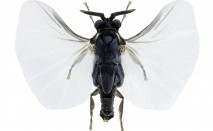
Category: Invertebrates

Also known as starfish, these echinoderms are found on the sea floors of all the world’s oceans from the equatorial tropics to frigid polar zones. There are around 1500 species of sea stars, some being able to survive at abyssal depths of 20,000 feet below the surface of the ocean. They usually have a central disc with five arms, though some exceptions have more. Their tube feet, which help them move, maneuver food, breathe, and also attach themselves firmly to rocks and other underwater structures, are operated by their “water vascular system,” a hydraulic system of interconnected fluid-filled canals. Their digestive system or “gut” occupies most of their central disc and also extend into their arms.
https://en.wikipedia.org/wiki/Starfish

Body horror in the insect kingdom
Learning about animals, you can discover many fascinating, even beautiful facts, but there are also things that can give you nightmares! Enter the strepsiptera (“twisted-wing parasite”). The adult female has no limbs, wings, or mouth - she simply lives in and feeds off her host (typically a wasp). When it becomes time to mate, she protrudes part of her abdomen from between the plates of her host and uses mind control to get the wasp to fly off to nearby males. Sexually mature males have wings, and fly around for about five hours before dying - spending their entire short existence seeking out females to mate with. After the female is impregnated, her own young grow and consume her. And once there is nothing left to eat, they leave their host wasp, infiltrate the nursery, and latch on to a larvae to create their own “zombie wasp” host and continue the grisly cycle!
Learn more >>
 Discover Animals is a web-based educational resource offered by the NAIA
Discover Animals is a web-based educational resource offered by the NAIA